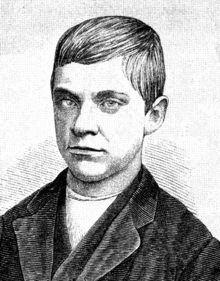- Jesse Pomeroy
-
Jesse Pomeroy 
The boy fiendBackground information Birth name Jesse Harding Pomeroy Born November 29, 1859
Charlestown, MassachusettsDied September 29, 1932 (aged 72) Cause of death natural causes Killings Number of victims: 2 Span of killings February, 1874–April, 1874 Country USA State(s) Massachusetts Date apprehended April 24, 1874 Jesse Harding Pomeroy (November 29, 1859 – September 29, 1932) was the youngest person convicted of the crime of murder in the first degree in the history of the Commonwealth of Massachusetts.
Contents
Background
Jesse Pomeroy was born in Charlestown, Massachusetts, to Thomas J. and Ruth Ann Pomeroy. He was the second of two children; his brother Charles Jr. was 2 years older.
Reported attacks in 1871–1872
In 1871–1872, there were reports that several young boys were individually enticed to remote areas and attacked by a slightly older boy. However, no one was ever arrested.
In 1872, Ruth and the two children moved to South Boston. Pomeroy's attacks on young boys continued, and he was finally arrested and his case heard in front of a juvenile court judge. Pomeroy was found guilty and sentenced to the Lyman School for Boys at Westborough, Massachusetts, for his minority (i.e., until he turned 18). The Boston Globe covered this story; the last line of the article: "It is generally concluded that the boy is mentally deficient."
The crime
In February 1874 at the age of 14, Pomeroy was paroled back to his mother and brother in South Boston. His mother ran her own dressmaking shop, and his brother Charles sold newspapers.
In March 1874, a ten-year-old girl from South Boston named Katie Curran suddenly went missing. On April 24, 1874, the mutilated body of four-year-old Horace Millen was found on the marsh of Dorchester Bay. Immediately, the police detectives sought out Pomeroy, despite lacking evidence implicating him in the crime. The body of Katie Curran was found later, in the basement of Pomeroy's mother's dress shop. Her remains were hastily and carelessly concealed in an ash heap.
The trial
Pomeroy was taken to view Millen's body and asked if he committed the murder. At the coroner's inquest, Pomeroy was denied the right to counsel.
The case of Commonwealth v. Pomeroy was heard in the Massachusetts Supreme Judicial Court (Suffolk County, Boston) on December 9 and December 10, 1874. At the trial, the Attorney General argued for a verdict of guilty in the murder of first degree. In his closing arguments, he urged an alternative charge of murder with extreme atrocity, which, according to Massachusetts law, is first degree murder, but differs from the original charge in the requirement of premeditation.
Pomeroy was pronounced guilty on December 10, 1874, with the jury's recommendation of mercy on account of the prisoner's youth.
Pomeroy's attorney, Charles Robinson, filed two exceptions which were overruled in February 1875, at which point Pomeroy was sentenced to hang until dead.
After the trial
 Charlestown State Prison, as depicted in 1840
Charlestown State Prison, as depicted in 1840
It remained for the Governor to sign the death warrant and assign a date for Pomeroy's execution. However, Governor William Gaston refused to comply with this executive responsibility. The only legal means of sparing Pomeroy's life was through the Governor's Council, and only if a simple majority of the nine-member Council voted to commute the death penalty. Over the next year and a half, the Council voted three times: the first two votes upheld Pomeroy's execution, and both times Governor Gaston refused to sign the death warrant. In August 1876, the Council took a third vote, anonymously, and Pomeroy's sentence was commuted to life in prison in solitary confinement. On the evening of September 7, 1876, Pomeroy was transferred from the Suffolk County Jail to the State Prison at Charlestown, and began his life in solitary. He was 16 years and 9 months old.[citation needed] Pomeroy remained incarcerated at the Charlestown State Prison.[1]
In 1917, Pomeroy's sentence was commuted to the extent of allowing him the privileges afforded to other life prisoners. At first he resisted, wanting nothing less than a pardon. He eventually adjusted to his changed circumstances and appeared in a minstrel show at the prison. In 1929, by this time an elderly man in frail health, he was transferred to Bridgewater Hospital for the Criminally Insane,[1] where he died on September 29, 1932.[citation needed]
Pop culture
- Jesse Pomeroy appears in the novel The Alienist by Caleb Carr
- Fiend: The Shocking True Story Of Americas Youngest Serial Killer by Harold Schechter
References
- ^ a b Gribben, Mark. "Jesse Harding Pomeroy." Crime Library. 17. Resurrection. Retrieved on November 27, 2010.
External links
- Additional information
-
- Court TV's Crime Library: Mark Gribben, "All about Jesse Pomeroy"
- Kobek.com Presents "The Autobiography of Jesse Harding Pomeroy, Written By Himself (1875)"
- Kobek.com Presents "Selections From the Writings of Jesse Harding Pomeroy, Life Prisoner Since 1876 (1920)"
- Jesse Harding Pomeroy: The teenaged killer
Categories:- 1859 births
- 1932 deaths
- Murder committed by minors
- American murderers of children
- Prisoners sentenced to life imprisonment by Massachusetts
- Prisoners sentenced to death by Massachusetts
- American people convicted of murder
- People convicted of murder by Massachusetts
- American people who died in prison custody
- Prisoners who died in Massachusetts detention
- People from Boston, Massachusetts
Wikimedia Foundation. 2010.
